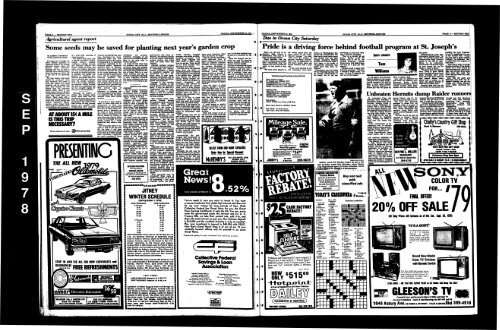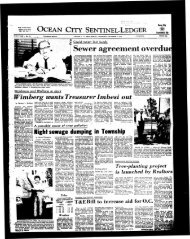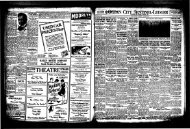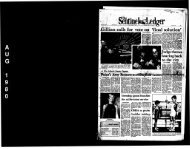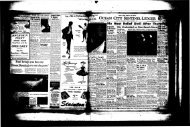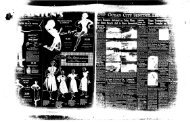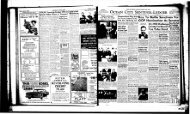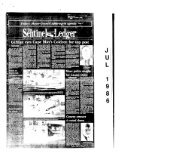Sep 1978 - On-Line Newspaper Archives of Ocean City
Sep 1978 - On-Line Newspaper Archives of Ocean City
Sep 1978 - On-Line Newspaper Archives of Ocean City
You also want an ePaper? Increase the reach of your titles
YUMPU automatically turns print PDFs into web optimized ePapers that Google loves.
PAGE 8 — SECTION TWO OCEAN CITY (N.J.) SENTINEL-LEDGER<br />
Agricultural agent report<br />
Some seeds may be saved for planting next year's garden crop<br />
By LARRY E. NEWBOLD<br />
County Agricultural Agent<br />
No matter how carefully you<br />
select limited quantities <strong>of</strong><br />
vegetable seeds for the coming<br />
growing season, there are<br />
always some leftovers.<br />
Although the cost <strong>of</strong> seed is<br />
minimal, one is usually hesitant<br />
about throwing out what's left<br />
at the end <strong>of</strong> the gardening<br />
year.<br />
For best results, fresh seeds<br />
should be purchased every<br />
year. However, most seeds, if<br />
fresh this spring and stored<br />
porperly, can be reused next<br />
year. Seed viability cnn also<br />
depend upon the particular<br />
season under which it was<br />
grown. Some, however, do have<br />
a fairly short storage life, even<br />
when kept under ideal conditions.<br />
Those seeds with a<br />
rather short storage life include<br />
sweet corn, onions, parsnip and<br />
hybrid tomatoes. Beans,<br />
carrots, celery, Swiss chard,<br />
beets, peppers, tomatoes, peas,<br />
and pumpkins will germinate 3<br />
to 4 years after purchase, if<br />
stored properly.<br />
The seed <strong>of</strong> other crops such<br />
as squash, cucumbers, turnips,<br />
radish, lettuce, melons,<br />
cauliflower, cabbage, broccoli,<br />
and Brussels sprouts will<br />
remain viable for nearly five<br />
years. Any leftover seed that<br />
has been stored should always<br />
be tested for viability just prior<br />
to planting next spring, and<br />
planted (if sufficient germination<br />
percentage exists) as<br />
soon as possible after removal<br />
from the storage container.<br />
Even if the storage conditions<br />
are optimum, always consider<br />
this seed as a supplement and<br />
not the complete supply for<br />
next year's planned garden.<br />
Although the subject is<br />
similar, this message about<br />
saving seeds deals with the<br />
drying and preserving <strong>of</strong> seeds<br />
from the ripened vegetables <strong>of</strong><br />
your garden. The results <strong>of</strong> this<br />
effort during the next growing<br />
season are usually very<br />
disappointing. Most vegetable<br />
AT ABOUT 15< A MILE<br />
IS THIS TRIP<br />
NECESSARY?<br />
Phone ahead and save.<br />
I New Jersey Bel<br />
varieties are hybrids that have<br />
been developed by. crosspollinating<br />
under very complicated<br />
processes that cannot<br />
be duplicated by an Individual<br />
pollinating vegetables in the<br />
backyard garden. Important<br />
qualities such as diseaseresistance,<br />
flavor, and-or yield<br />
are bred into hybrids. The seed<br />
<strong>of</strong> the second generation (the<br />
saved seed that is planted next<br />
year) will not possess> these<br />
essential qualities. The<br />
desirable characteristics in<br />
each hybrid variety last for<br />
only one generation. If they are<br />
important to you, you must buy<br />
and plant new seed each year.<br />
With certain types <strong>of</strong><br />
vegetables, sich as wiltresistance<br />
<strong>of</strong> tomatoes and<br />
virus-free peppers and melons,<br />
it is imperative that the home<br />
gardener select these hybrid<br />
varieties.<br />
If you have a pine, cherry,<br />
apple, or some other kind <strong>of</strong><br />
ornamental or fruit tree<br />
growing in your yard and find<br />
neat rows <strong>of</strong> holes (about onequarter<br />
inch in diameter) on<br />
the trunk or main branches,<br />
don't jump to conclusions that<br />
they're caused by borers or<br />
some other type <strong>of</strong> insect. Holes<br />
<strong>of</strong> this sort in straight rows are<br />
usually caused by a woodpecker-like<br />
bird called a sapsucker.<br />
The bird pecks holes in the<br />
trunk to feed on the sap that<br />
fills the holes. It has been<br />
reported that trees can be killed<br />
by this bird if it makes enough<br />
holes. Personally, I would not<br />
get overly concerned if these<br />
PRESENTING<br />
THE AIL NEW<br />
wmi<br />
STOP IN AND SEE All THE NEW CHEVROIETS and<br />
OLDSMOBIIES FREE REFRESHMENTS<br />
ctlmei Chevrolet-Oidsmobile<br />
ink I SUVSON AVI.<br />
ocfAManmttts<br />
OUC 4IM RUNM tV&JUJU<br />
USO CA!<br />
l<br />
OMOJAUTY<br />
symptoms are present.<br />
Countless examples <strong>of</strong> old<br />
specimen trees exhibiting these<br />
holes in the bark exist in<br />
healthy splendor.<br />
If a few <strong>of</strong> your trees have<br />
this problem, and you're still<br />
concerned about the pecking,<br />
try placing teetanglefoot in twoinch<br />
bands above and below the<br />
row <strong>of</strong> holes. This is a very<br />
sticky material and Just as<br />
much <strong>of</strong> a nuisance to the birds<br />
or other uninvited creatures<br />
that desire climbing in the tree<br />
as it will be to you trying to put<br />
it on.<br />
MAKING AND USING<br />
COMPOST<br />
What is compost? Compost is<br />
a dark, friable, partially<br />
decomposed form <strong>of</strong> organic<br />
matter similar in nature to the<br />
organic matter in the soil.<br />
Why make compost?<br />
Disposing <strong>of</strong> leaves, grass<br />
cuppings, and other garden<br />
refuse is <strong>of</strong>ten a problem for<br />
gardeners, particularly in<br />
urban areas: These byproducts<br />
<strong>of</strong> the garden and landscape<br />
can be turned into useful<br />
compst with no more effort<br />
than it takes to bag and haul<br />
them away.<br />
In many cases the compost<br />
will serve the same function as<br />
peat moss and thereby reduce<br />
gardening costs. Returning<br />
these organic materials to the<br />
land. perpetuates natural<br />
biological cycles and is an<br />
ecologically sensible means <strong>of</strong><br />
using organic wastes.<br />
The value <strong>of</strong> compost. Good<br />
compost consists <strong>of</strong> a small<br />
amount <strong>of</strong> soil along with<br />
decomposed or partially<br />
decomposed plant and animal<br />
residues. As a soil amendment,<br />
compost . improves both<br />
physical condition and fertility,<br />
uis especailly useful for Improving<br />
soils that are low in<br />
organic matter.<br />
The organic matter in the<br />
compost makes heavy clay<br />
soils easier to work by binding<br />
the soil particles together. Such<br />
aggregation <strong>of</strong> the soil particles<br />
helps improve aeration, root<br />
INTERIOR PAINTING<br />
Fall and Winter<br />
SPECIAL RfcTES<br />
3 Rooms for the Pflce <strong>of</strong> a<br />
Fully Insured • Fred Estimates<br />
20 Years Experience<br />
398-0265<br />
penetration, and water infiltration,<br />
and reduces crusting<br />
<strong>of</strong> the soil surface. Additionally<br />
organic matter also helps<br />
sandy soil retain water and<br />
nutrients.<br />
Although compost contains<br />
nutrients, its greatest benefit is<br />
in improving soil characteristics.<br />
Therefore, it should<br />
be considered valuable soil<br />
amendment, and not a fertilizer,<br />
since, in most cases,<br />
additional fertilization will be<br />
necessary to achieve maximum<br />
growth and production.<br />
Compost is also valuable<br />
mulching material to use<br />
around garden and landscape<br />
plants. It may be used as a<br />
"topdressing" for lawns and,<br />
when it contains a small<br />
amount <strong>of</strong> soil, as a growing<br />
medium for house plants or for<br />
starting seedlings.<br />
How compost forms. Composting<br />
speeds natural<br />
" decomposition under controlled<br />
conditions. Raw organic<br />
material is converted into<br />
compost by the action <strong>of</strong><br />
microorganisms (fungi and<br />
bacteria). During intiail stages<br />
<strong>of</strong> composting, microorganisms<br />
increase rapidly. As the<br />
materials decompose, some<br />
kinds <strong>of</strong> microorganisms<br />
predominate. But as the<br />
complete a certain function<br />
these microorganisms decline<br />
while others build up and<br />
continue the decomposition.<br />
As microorganisms<br />
decompose the organic<br />
materials, temperatures within<br />
the pile approach MO to 160<br />
degrees at the center. This kills<br />
some <strong>of</strong> the weed seeds and<br />
diseaseorganlsms in these high<br />
temperature areas. However,<br />
in cooler sections <strong>of</strong> the heap<br />
such sterilization does not<br />
occur.<br />
Organisms that are largely<br />
responsible for the breakdown<br />
<strong>of</strong> the organic materials<br />
require large quantities <strong>of</strong><br />
nitrogen. Therefore, adding<br />
nitrogen fertilizer or materials<br />
supplying large amounts <strong>of</strong><br />
nitrogen is necessary for rapid<br />
and thorough decomposition.<br />
During the Dreakdown period<br />
this nitrogen is tied up, and not<br />
available for plant use. It is<br />
released, however, when the<br />
; 4wx>T n p<strong>of</strong>


